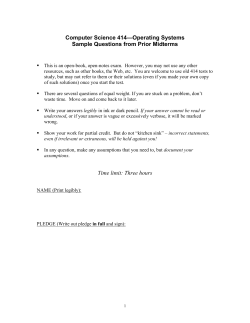
ary Friend PrEng Sales Director EXTECH SAFETY SYSTEMS PTY LTD
Gary Friend PrEng Sales Director EXTECH SAFETY SYSTEMS PTY LTD TEL : +27 (0) 11 791 6000 FAX : +27 (0) 11 792 8294 CELL : +27 (0) 83 309 8200 http://www.extech.co.za How to calculate an Intrinsically Safe loop approval. A Galvanic Isolator is an active device that energy limits without the dependence on the IS earth for safety. It also has the advantage of supplying higher voltage at the hazardous area terminals and allowing longer cable lengths. Isolators have local LED indication and most 4-20 mA isolators transfer Hart communications. We all know what can happen when the correct techniques are not used when interfacing into the Hazardous Area. Using Intrinsic Safety (Ex i based on IEC/SANS 60079-11; IEC/SANS 6007925), the energy in the hazardous area is limited to below the ignition energy of the gas present, thereby preventing explosions. The principle for loop approval is the same for zener barriers & galvanic isolators, but first let’s define Ex i and which hazardous zone they can be used in. For an explosion, all three, gas/dust, oxygen and source of ignition (spark or heat) need to be present. Intrinsic Safety works on the principle of removing the source of ignition. This can be achieved by using a Zener Barrier or Galvanic Isolator. A zener barrier is a simple device where the voltage is limited by a zener diode and the current by a resistor. The fuse is there to protect the zener diode. The key to safety is the Intrinsically safe earth. Without it, there is no protection. If the input voltage increases above zener diode voltage, the zener conducts & the fuse blows. The zener barrier has to be replaced. In addition, the zener barrier has a volt drop across it under operating conditions so careful calculation must be done to ensure there is sufficient voltage at the field device. As you can see from figure below, the barrier/isolator has [EEx ia] IIC. The square brackets indicate that the barrier/isolator (mounted in safe area) can have connections to hazardous area. In this case Ex ia i.e. zone 0. IIC is the gas group. The transmitter has EEx ia IIC T4. This means it can be located in zone 0 in gas group IIC. T4 is the maximum surface temperature of device (135°C). The barrier/isolator has maximum output parameters for voltage, current and power Uo Io Po. These are maximum output values under fault conditions (known as Safety Description or entity parameters). The field device has maximum input parameters Ui Ii Pi which are the maximum values that can be applied under fault conditions and still be safe. NOTE: USING ZENER BARRIERS WITHOUT AN IS EARTH IS NOT SAFE! 1 Gary Friend PrEng Sales Director EXTECH SAFETY SYSTEMS PTY LTD TEL : +27 (0) 11 791 6000 FAX : +27 (0) 11 792 8294 CELL : +27 (0) 83 309 8200 http://www.extech.co.za NOTE: FOR A SAFE LOOP ALL THREE INPUT PARAMETERS MUST BE GREATER THAN OR EQUAL TO OUTPUT PARAMETERS (Ui ≥ Uo, Ii ≥ Io, Pi ≥ Po) NOTE: Ex nL has been replaced by Ex ic for zone 2 in the standards. This means Intrinsic Safety can easily be used in zones 0, 1 & 2 and the wiring can be in same multi-core cable and/or trunking! Another advantage of Ex ic is that the safety factor of 1.5 (as shown in Table A.2 of SANS/IEC 60079-11) does not need to be applied to cable parameters allowing for longer cable runs. NOTE: BARRIER/ISOLATOR SAFETY PARAMETERS SHOULD NOT BE CONFUSED WITH OPERATIONAL PARAMETERS. Conclusion: Flameproof (Ex d) offers hazardous area protection for zone 1 and 2 and offers protection for higher voltage (110Vac, 220Vac) applications and requires mechanical planning & preparation. For 24V systems, Intrinsic Safety offers a simple & flexible solution for zone 0, 1 & 2. Intrinsic Safety is the only protection that considers faults of the field wiring and offers live working without the need for a gas clearance certificate. It does require some design and planning to ensure that the system loop analysis is acceptable. To complete the system loop approval, the electrical stored energy (cabling) needs to be considered. Table A.2 in IEC/SANS 60079-11 lists the maximum cable capacitance against output voltage. In the example below the maximum electrical stored energy that can be connected to the hazardous area terminals is 83nF 4.2mH. The transmitter has internal capacitance and inductance, so maximum cable capacitance Cc = Co-Ci and maximum inductance Lc = Lo-Li. (Alternatively the cable L/R ratio can be used). The cable specification typically gives pF/m and μH/m allowing a calculation of maximum cable length. Based on this assessment, a system certificate or loop approval can be documented. NOTE: INSERTING A BARRIER OR ISOLATOR WITH A NONCERTIFIED (ACTIVE) FIELD DEVICE IS NOT SAFE! Some field devices like thermocouples are defined as Simple Apparatus. A simple loop drawing is still required and an assessment of power/maximum surface temperature needs to be completed. 2
© Copyright 2025





















